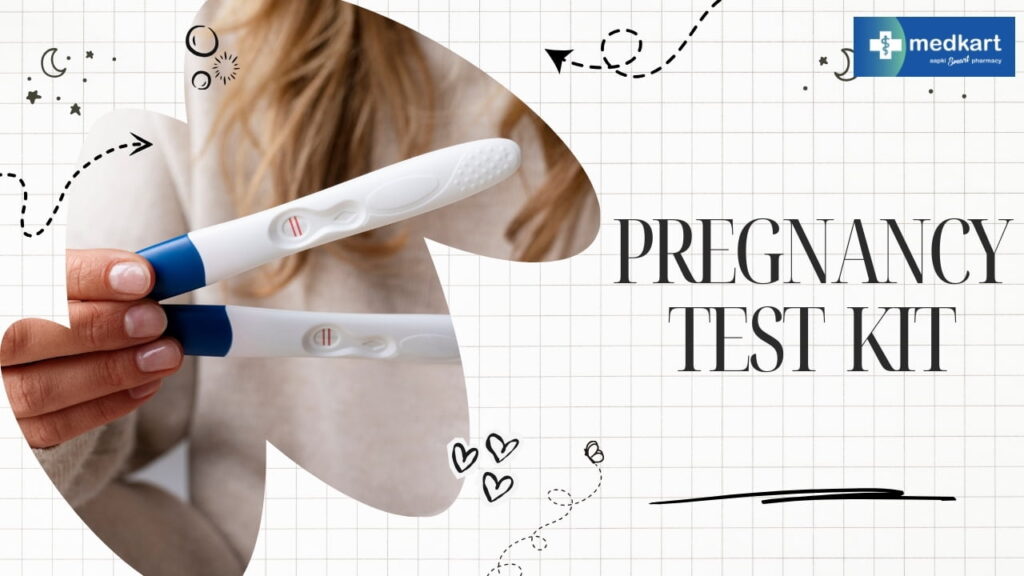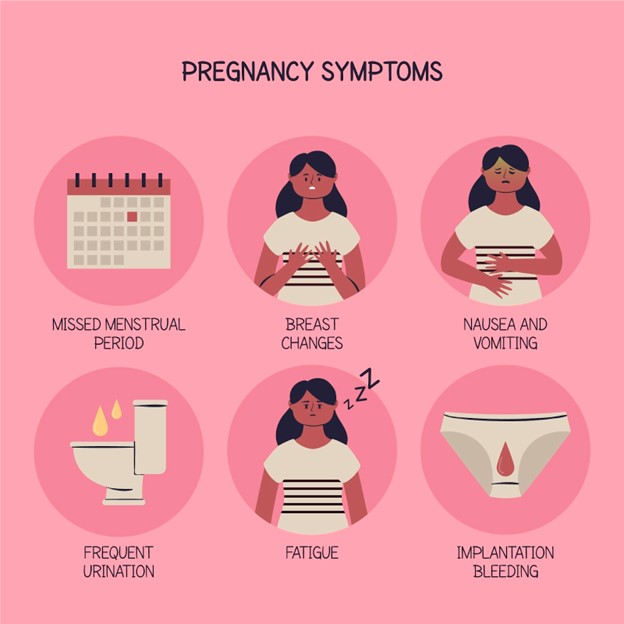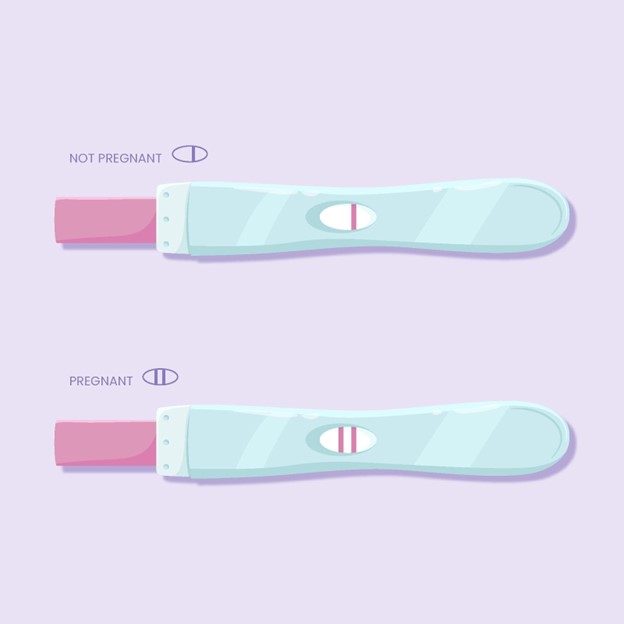Last updated on April 11th, 2025 at 01:35 pm
 Pregnancy Test Kit | Pregnancy Test Instructions
Pregnancy Test Kit | Pregnancy Test Instructions
Bringing a new life into the world is one of the most significant and joyous events in many people’s lives. However, the journey to parenthood often begins with the anticipation and uncertainty of whether or not a pregnancy has occurred. This is where pregnancy test kits come into play, offering a quick and convenient way to confirm whether or not conception has taken place.
Over-the-counter products widely available are pregnancy test kits, designed to detect the presence of human chorionic gonadotropin (hCG), a hormone produced during pregnancy when a fertilized egg implants itself in the uterus, causing the body to begin producing hCG, which can be detected in urine and blood.Pregnancy test kits primarily detect hCG levels in urine, providing a reliable indication of pregnancy within minutes.
How Do Pregnancy Test Kits Work?
Most pregnancy test kits utilize a simple mechanism to detect hCG in urine. The typical pregnancy test kit consists of a plastic casing, a test strip or stick, and a cap. The test strip contains antibodies that specifically react with hCG. When a urine sample is applied to the designated area on the test strip, any hCG present binds to the antibodies, initiating a chemical reaction that produces visible lines or symbols that indicate a positive or negative result.

How to Use a Pregnancy Test Kit: A Step-by-Step Guide
Taking a pregnancy test can be a momentous occasion, filled with anticipation and excitement. Whether you’re eagerly hoping for a positive result or nervously awaiting confirmation, knowing how to use a pregnancy test kit correctly is essential for accurate results. In this step-by-step guide, we’ll walk you through the process of using a pregnancy test kit effectively.
Choose the Right Test Kit:
- Before purchasing a pregnancy test kit, consider factors such as sensitivity, ease of use, and digital versus traditional readouts. Choose a test kit that aligns with your preferences and needs.
Read the Instructions:
- Take a few moments to carefully read the instructions provided with the pregnancy test kit. Each brand may have specific guidelines for usage, so it’s essential to familiarize yourself with the process beforehand.
Collect Urine Sample:
- If you’re using a traditional strip test:
- Use a clean cup to collect a small amount of urine, preferably using the first-morning urine for the highest concentration of hCG.
- Alternatively, you can hold the absorbent tip of the test stick in your urine stream for a few seconds if you’re using a midstream test.
Perform the Test:
- Remove the pregnancy test kit from its packaging, taking care not to touch the absorbent tip or any other sensitive areas.
- If you’re using a traditional strip test:
- Dip the absorbent tip of the test strip into the urine sample for the specified duration, usually a few seconds.
- Alternatively, you can use a dropper to apply a few drops of urine to the designated area on the test strip.

Wait for Results:
- Place the test kit on a flat surface and wait for the specified amount of time, typically between 3 to 5 minutes, before interpreting the results.
- Avoid moving or disturbing the test kit during this time to prevent inaccurate results.
Interpret the Results:
- After the designated waiting period, check the test for the appearance of lines, symbols, or digital readouts.
- Depending on the brand and type of test kit, a positive result may be indicated by the appearance of one or two lines, a plus sign, the word “pregnant,” or a similar indication.
- A negative result typically displays as a single line, a minus sign, the words “not pregnant,” or a similar indication.
Dispose of the Test Properly:
- Once you’ve interpreted the results, dispose of the pregnancy test kit according to the manufacturer’s instructions.
- Most test kits can be discarded in the regular trash, but be sure to check for any specific disposal guidelines provided.
Seek Further Guidance if Necessary:
- If you receive a positive result, consider scheduling an appointment with your healthcare provider to confirm the pregnancy and discuss next steps.
- If you receive a negative result but suspect you may still be pregnant or if your period is significantly delayed, consider repeating the test after a few days or seeking guidance from a medical expert for additional assessment and examination.
By following these step-by-step instructions and exercising patience and care during the testing process, you can effectively use a pregnancy test kit to determine whether or not you’re pregnant. Remember, while using pregnancy test kits correctly generally yields accurate results, it’s always advisable to consult with a healthcare professional for confirmation and guidance, ensuring peace of mind and comprehensive care.
Types of Pregnancy Test Kits
There are several types of pregnancy test kits available on the market, each offering its own set of features and benefits:
-
Traditional Strip Tests:
These are the most common type of pregnancy test kits. Users collect a urine sample in a cup and then dip the test strip into the sample or use a dropper to apply urine directly onto the test strip. Results typically appear within a few minutes.
-
Midstream Tests:
Midstream tests are designed for convenience, allowing users to hold the test stick directly in their urine stream. These tests often come with a cap to cover the absorbent tip, which is removed before testing. Outcomes typically become evident within a matter of minutes.
-
Digital Tests:
Digital pregnancy test kits provide a clear digital readout of the results, eliminating the need for interpretation of lines or symbols. These tests often feature a screen that displays “pregnant” or “not pregnant” rather than traditional line indicators.
-
Early Detection Tests:
Some pregnancy test kits claim to detect lower levels of hCG, allowing for earlier detection of pregnancy before a missed period. These tests may be more sensitive, but are typically more expensive.
-
Rapid Tests:
Rapid pregnancy tests provide results in as little as one minute, offering quick confirmation of pregnancy without the need to wait several minutes for results to appear.
Conclusion
Pregnancy test kits offer a simple and convenient way to confirm pregnancy in the comfort of your own home. With a variety of options available, including traditional strip tests, midstream tests, digital tests, early detection tests, and rapid tests, individuals can choose the product that best suits their needs. By following the tips outlined in this guide and using pregnancy test kits correctly, individuals can achieve accurate results and gain peace of mind during the early stages of pregnancy. Remember, if you have any concerns about pregnancy or the results of a pregnancy test, consult with a healthcare professional for further guidance and support.
FAQs On Pregnancy Test Kit
1. What is a pregnancy test kit?
Answer: A pregnancy test kit is a diagnostic tool used to detect the presence of human chorionic gonadotropin (hCG), a hormone produced during pregnancy, in a woman’s urine. It typically consists of a test strip or stick that reacts with hCG to indicate whether or not a woman is pregnant. These kits provide a quick and convenient way for individuals to confirm pregnancy in the privacy of their own homes.
2. How soon can I take a pregnancy test after a missed period?
Answer: You can take a pregnancy test as early as the first day of your missed period. However, for the most accurate results, it’s advisable to wait at least one week after your missed period to ensure sufficient levels of the pregnancy hormone, hCG, have built up in your system.
3. Can medications or medical conditions affect the accuracy of a pregnancy test?
Answer: Certain medications, medical conditions, and fertility treatments can potentially interfere with pregnancy test results. It’s essential to consult with a healthcare professional if you’re taking any medications or have medical conditions that may impact the accuracy of the test.
Also Read:-
